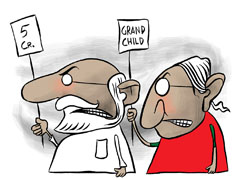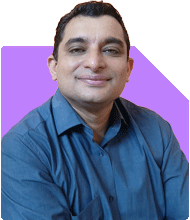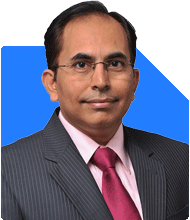Ramalingam Kalirajan |10902 Answers |Ask -Follow
Mutual Funds, Financial Planning Expert - Answered on Jun 21, 2025
He has an MBA in finance from the University of Madras and is a certified financial planner.
He is the director and chief financial planner at Holistic Investment, a Chennai-based firm that offers financial planning and wealth management advice.... more

How to use Rs.35-40lacs in the best possible way ? I donot have a job currently and no investments on my name. Whatever i had in the name of savings in the past.. is all gone. I don't want to get into details but it was used to settle dues of people i loved the most.
Immediate Cash Allocation and Liquidity Plan
Set aside an emergency buffer
Keep Rs.?5–7?lakh in a liquid safety net.
Use a high?liquidity option like a savings account or liquid fund.
This secures unplanned needs and reduces stress now.
Allocate short?term funds
Dedicate Rs.?5?lakh for near?term opportunities or essential spending.
This gives flexibility for job search, skill building, or family needs.
Retain remaining corpus cautiously
The balance of Rs.?23–30?lakh should be used with clarity and stage?wise planning.
Don’t deploy it all in one go or without strategy.
Income Restoration and Career Strategy
Invest in your employability
Use Rs.?1–2?lakh to learn new skills or upgrade certifications.
This enhances job prospects if re?employment is the goal.
Explore part?time or freelance work
Even small monthly income can build confidence and restart cash flow.
Assess self?employment or business start
If you have ideas or passion, use some funds to pilot small ventures.
Keep initial capital under Rs.?5 lakh to test viability.
Leveraging Actively Managed Mutual Funds
Commit to equity mutual fund SIPs
Start monthly SIPs of Rs.?30k–50k in actively managed funds.
These can potentially give good long?term growth.
Index funds just mirror the market. They lack active risk control.
Active funds can manage volatility better for small investors.
Use regular plans via Certified Financial Planner
Regular plan adds value through expert help and goal tracking.
Direct plans lack ongoing guidance and portfolio alignment.
Split investments over time
Do not invest the full amount at once.
Spread investments in tranches (e.g. monthly over 4–5 months).
This approach reduces risk from market timing.
Include hybrid or balanced funds
Add stability with part equity and part debt.
This aids smoother returns and periodic income.
Insurance and Protection
Take health insurance immediately
Get family floater policy with sufficient cover for hospital care.
Personal health needs to be covered before investing heavily.
Obtain term life insurance if dependents exist
A term cover of Rs. 1–2 crore is essential if you have family responsibilities.
Premiums are affordable and peace of mind is invaluable.
Avoid life?investment combo policies
If you have such plans, consider surrendering them.
Use any surrender value to fund mutual funds with expert support.
Debt Liability and Future Borrowing
Avoid new loans until investment discipline is solid
With no current income, minimizing liabilities is prudent.
Prioritize stable cash flow before taking on debt.
Check any existing dues or informal lending
If there are outstanding liabilities, pay them with part of the corpus.
This frees mental and financial stress.
Financial Planning and Goal Setting
Define clear short, medium, and long?term goals
Short: Secure income and health protection
Medium: Build Rs.?1–2?crore corpus in 5–7 years
Long: Achieve financial independence or retirement buffer in 8–10 years
Quantify investment needs for each goal
For example, Rs.?30k monthly SIP for 7 years can accumulate ~Rs.?45–50?lakh.
A combination of SIPs in equity and hybrid funds can reach larger targets.
Track monthly progress with your CFP
Regular reviews ensure you stay on track and adjust to changes.
Risk Management and Asset Allocation
Retain liquidity year?round
Emergency buffer plus part SIP ensures flexibility.
Asset mix recommendation
Start with 60–70% equity and 30–40% hybrid/debt mutual funds.
Adjust based on your risk comfort and time horizon.
Review midway through the plan
At 3?year marks, adjust allocation based on performance and life changes.
Tax Planning for Wealth Efficiency
Understand capital gains tax
Equity funds: Gains above Rs. 1.25 lakh taxed at 12.5%.
Debt funds: Gains taxed as per income slab.
Plan redemptions and SIPs to manage this tax impact.
Use tax benefits in NPS or other retirement schemes
If your income taxes apply later, these can help reduce tax burden.
Professional Guidance and Accountability
Work consistently with a Certified Financial Planner
CFP helps with portfolio alignment, goal adjustment, and tracking.
Regular check?ins strengthen discipline and clarity.
Avoid making investing decisions alone
Mistimed entry or panic selling hurt returns. CFP support helps avoid this.
Psychological and Behavioural Planning
Accept this is a fresh phase
You overcame past difficulties. That shows strength.
Treat this corpus as an opportunity, not a chance for revenge spending.
Build positive money habits daily
Track expenses, stay within budget, pay SIPs promptly.
Small habits lead to big financial health.
Guard against impulsive spending
With Rs. 35–40 lakh ready, temptation may arise.
Have clear purpose and break funds into buckets.
Step?by?Step Investment Roadmap
Allocate Rs.?5–7?lakh to liquid buffer
Invest Rs.?1.5–2?lakh in career upgrade or skill
Start equity SIPs of Rs.?30–40k monthly
Add Rs.?10k–15k monthly in hybrid fund SIP
Secure health and term insurance covers
Review and top?up investment allocations every 6 months
Consider starting part?time income streams or micro venture
Accumulate Rs.?1–2?crore corpus in 5–7 years
Reassess goals and move towards financial independence
This roadmap gives structure, flexibility, and control.
Final Insights
You have exhibited immense strength in restarting. Now you can rebuild with purpose. Use part funds for security and growth. Build new income streams. Invest in actively managed funds via Certified Financial Planner. Avoid index funds and direct plans lacking expert support. Keep liquidity intact. Start simple SIPs. Protect yourself with insurance. Track goals and habits. This can restore not just money, but confidence and freedom.
Best Regards,
K. Ramalingam, MBA, CFP,
Chief Financial Planner,
www.holisticinvestment.in
https://www.youtube.com/@HolisticInvestment
You may like to see similar questions and answers below
Kirtan A Shah | Answer |Ask -Follow
MF Expert, Financial Planner - Answered on Jul 28, 2023
Ramalingam Kalirajan |10902 Answers |Ask -Follow
Mutual Funds, Financial Planning Expert - Answered on Apr 30, 2024
Ramalingam Kalirajan |10902 Answers |Ask -Follow
Mutual Funds, Financial Planning Expert - Answered on Apr 12, 2024
Ramalingam Kalirajan |10902 Answers |Ask -Follow
Mutual Funds, Financial Planning Expert - Answered on May 10, 2024
Ramalingam Kalirajan |10902 Answers |Ask -Follow
Mutual Funds, Financial Planning Expert - Answered on Jun 24, 2025
Anu Krishna |1749 Answers |Ask -Follow
Relationships Expert, Mind Coach - Answered on Dec 17, 2025
Anu Krishna |1749 Answers |Ask -Follow
Relationships Expert, Mind Coach - Answered on Dec 17, 2025
Radheshyam Zanwar |6748 Answers |Ask -Follow
MHT-CET, IIT-JEE, NEET-UG Expert - Answered on Dec 17, 2025
Anu Krishna |1749 Answers |Ask -Follow
Relationships Expert, Mind Coach - Answered on Dec 17, 2025
Dr Shakeeb Ahmed Khan |184 Answers |Ask -Follow
Physiotherapist - Answered on Dec 17, 2025
T S Khurana |538 Answers |Ask -Follow
Tax Expert - Answered on Dec 17, 2025
T S Khurana |538 Answers |Ask -Follow
Tax Expert - Answered on Dec 17, 2025
Janak Patel |72 Answers |Ask -Follow
MF, PF Expert - Answered on Dec 17, 2025
Ramalingam Kalirajan |10902 Answers |Ask -Follow
Mutual Funds, Financial Planning Expert - Answered on Dec 17, 2025
Samraat Jadhav |2511 Answers |Ask -Follow
Stock Market Expert - Answered on Dec 17, 2025




























